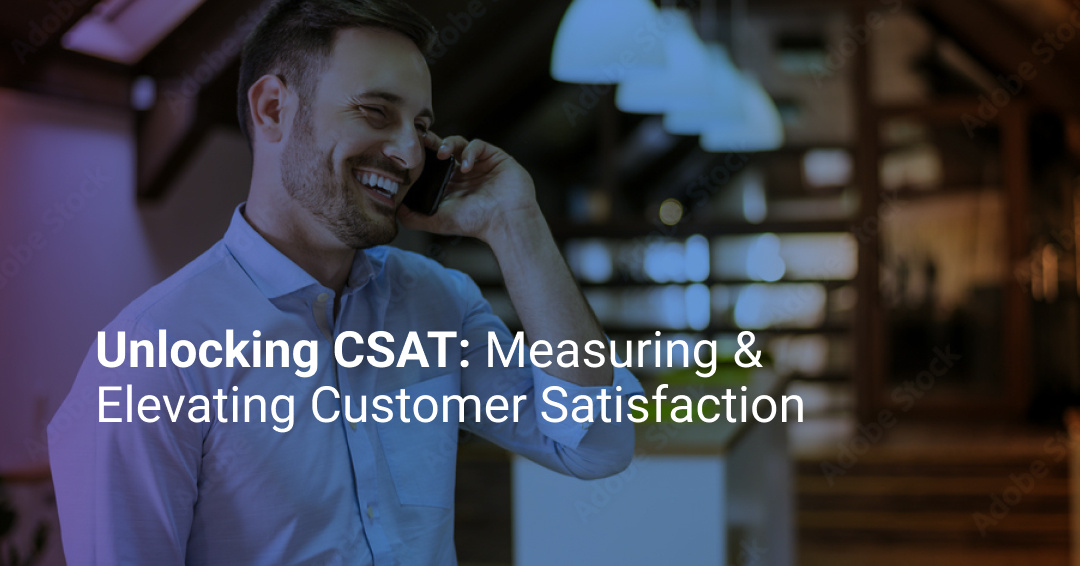12 Call Center Metrics You Should Be Using to Improve CX in 2025
Call center metrics are the most important performance indicators that monitor how effectively your call center is running. This includes anything...
7 min read
![]() Mosaicx
:
July 16, 2024
Mosaicx
:
July 16, 2024

According to G2, 40% of millennials engage with bots daily, and around 1.4 billion people use chatbots for communication. That represents a massive opportunity for enterprises to leverage. But just because people are using chatbots doesn’t mean they like it. How can you tell if enterprise chatbots are helping your organization or slowly pushing customers away? This article will help you find the answer.
Chatbots are automated, web-based tools that communicate with people through text. Not all chatbots are alike. There are very simple chatbots to bounce ideas, manage simple interactions, or create lists. Enterprise chatbots are different. They aim to provide profit-driven solutions to help organizations scale and optimize their processes. Enterprise chatbots are built to handle first contact with customers, which is cheaper than letting customers contact a human agent.
They are also generally designed to integrate with other departments and tools (CRMs, ERPs, HR tools, etc.). Advanced options manage large volumes of customer service interactions and meet compliance standards and industry regulations.
The market for enterprise chatbot solutions is significant, and there are multiple options with a myriad of features and limitations. Companies must do due diligence to find a reliable provider.
Enterprise chatbots have multiple applications and uses that help organizations meet their objectives and become more efficient. Not all chatbots are alike, but in general, most of them fall short and create frustrating experiences for customers. However, there are a few benefits that keep bringing companies back to chatbots.

Customer support at the enterprise level is always a challenge. The volume of interactions and the quality of service and engagement you can provide is a delicate equation harder to crack than most anticipate. Chatbots are a basic solution that can help organizations answer customer requests quickly by automating repetitive tasks and letting customers solve problems themselves. But for issues beyond finding a location, getting order information, FAQ and the like, chatbots are an ineffective solution. Conversational AI tools that use machine learning technologies to adapt to each interaction resolve a wider range of issues and create a better experience.
Becoming more efficient is an objective for most organizations. Chatbots automates repetitive tasks more efficiently than human agents. For example, if a software company is experiencing an outage, they can program a chatbot to address the outage and deliver the same message to everyone. This only works for people who choose to use the chatbot, however. It is not a proactive, outbound solution.
Having your human agents focus on more complicated interactions while automating common requests means you can get more done without financial overhead. These operational improvements can lead to further training and specialization for your employees on the things that actually matter rather than being stuck on FAQ conversations that could have been easily automated.
To automate a wider range of interactions – and create a more interactive experience – consider a conversational AI solution instead of an enterprise chatbot. Chatbots work for very simple and streamlined customer service cases, while conversational AI is more versatile, helps in more scenarios, and generally leads to better CX results.
You can map multiple data points to inform strategic decisions and tactical actions by fully integrating technology such as a chatbot or conversational AI solution. While this varies for each organization, most companies with high volumes of interactions can identify patterns to improve problem resolution rates, prevent customers from churning, and even find new outbound opportunities based on geographic location, timing, demographics, and plenty of other factors.
While there are limitations to most chatbots compared to conversational AI solutions, having precise segmentation and objectives for both technologies can help you engage with customers. Beyond the decision tree nature of most chatbots, companies can also create rules to help the chatbot identify VIP customers or particular segments to prioritize different paths. For example, if you know a specific customer prefers to be transferred directly to a human agent or frequently asks the same question, you could do so with some providers.
Despite the limitations, organizations have adopted chatbots and conversational AI technologies to their operating models in many ways. Here, we will discuss some of the most prominent ways companies use them.
Providing excellent customer service and support at scale is a challenge for all organizations. With chatbots, multiple FAQ and common concerns can be addressed automatically. That is not to say that these technologies can permanently run your customer service or that they do not require some human supervision. Instead, they allow customers to solve simple problems, contacting a human agent only for more advanced requests.
With conversational AI solutions, you can proactively reach out to customers to provide better service and support, adding a predictive element chatbots lack. Mosaicx, for example, uses conversational AI to create human-like interactions and predictive analytics to anticipate problems before they occur.
In the retail and e-commerce industry, companies use chatbots to interact more actively with their customers, help them with common concerns and questions, and offer promotional materials. Users can solve problems on their own – like get store hours, find a location, check shipping info, etc. – without talking to a customer service representative, which can lead to hold times and frustration.
The healthcare vertical is a complicated one with a balance between efficiency and privacy. There are multiple activities, such as renewing a prescription or accessing patient information, that can be handled by a chatbot, but the challenge doesn’t stop there. Beyond efficiency, these technologies must also provide a layer of privacy and data protection. Not all chatbot providers are HIPAA compliant. Healthcare organizations must take special care to find a provider who knows the ins and outs of the industry. You should consult your legal team before selecting any new technology provider.
Checking your balance. Reviewing your credit score. Getting information about recent transactions. Banks use chatbots to handle all these activities. Like the healthcare vertical, finance comes with its own regulations and security considerations. You must find a provider who specializes in the banking industry. If you do, automated solutions help your members take ownership of their financial health.
The use cases for chatbots and conversational AI solutions in IT and tech support are varied and extensive. Basic chatbots can help people find solutions to FAQs, report issues, and, in some cases, solve more complicated problems. More advanced conversational AI tools with human-like interactions, on the other hand, help users solve all types of problems, including more complex and nuanced scenarios where capturing and interpreting user intent is required for the conversation to move forward naturally.
In the case of Mosaicx, our enterprise IT and tech support clients use conversational AI to:
Another common use that has been booming in the last couple of years is sales qualification and growth. Managing large volumes of potential leads is a very difficult task. You must understand who they are, their problems, and the potential solution you can pitch them at scale. It requires an organized and thorough approach that provides the correct type of information at every step of their journey.
LinkedIn ads sent via chat allow the recipient to choose from a set of predetermined responses. This is a very basic chatbot that is focused on getting the recipient in contact with sales. Omnichannel conversational AI tools go a step further, as they’re able to proactively follow up without an active human agent handling the conversation. The results are a more efficient sales engine, more profits for the company, and the capacity for sales teams to focus on higher-value tasks instead of repetitive ones.
Before considering implementing an enterprise chatbot organizations need to remember some of the best practices to avoid expensive mistakes or buying the wrong type of product for your needs.
Chatbots must match your audience's habits and technological abilities. People may be comfortable using a chatbot in technologically advanced, low-risk verticals like car rentals. But for high-risk products and services, like home construction or veterinary services, it may not be a good fit. If you do add a technology layer in these verticals, it must exhibit cultural empathy to ensure whatever is created can be used and actually adds value to customers. In this regard, conversational AI has a far superior edge by being able to adapt given its intent-capturing abilities rather than being limited by previously set up and closed decision trees.
As mentioned, security and privacy are vital to users today. When it comes to chatbot providers, there are all types of offers, products, and security quality levels to consider. Smaller startups can build functional products. Still, privacy and security measures may not necessarily be one of their top priorities. Likewise, mature providers with experience in enterprise privacy, security, and compliance need to move differently to ensure no shortcuts are taken if they can potentially lead to issues down the road.
It’s a good practice to go through multiple chatbot training interactions before going live. While chatbots can indeed help companies automate their operations, they require human supervision to ensure standards are met. The best way to do this is to have a training period where proper QA processes prevent real users from having poor interactions with chatbots, burning your brand equity and leading to frustration.
Though enterprise chatbots have benefits, they have major limitations. The most evident issue is that they may fail at solving complex or nuanced problems. They're great with predetermined journeys and FAQ scenarios, but they often may not be enough to provide answers to customers. This is why, beyond using a chatbot, training agents who can handle more complex problems is still essential.
On top of that, chatbots have little to no emotional intelligence. They do not identify the emotional tone in conversations, and programmers usually add an overly positive tone to every pre-programmed message, which is infuriating when a customer is upset. More advanced conversational AI solutions are better at identifying intent and clearly transferring calls to qualified human agents..
Finally, chatbots are only as good as your organization’s data. Data can be outdated, biased, or simply not complete or specific enough, leading to inaccurate or misleading answers. You may create a user journey to solve a common problem, but the problem is more nuanced than expected, and you end up frustrating more users than you help. Plus, the chatbot usually operates in a vacuum. Most providers are unable to take over the complex and resource-heavy task of ensuring all customer-facing systems talk to one another.
Chatbots tend to be simple, trained on predetermined decision trees, and limited in scope. Conversational AI, on the other hand, particularly intelligent virtual agents (IVAs), can provide better answers to more complex user queries and scenarios.
A chatbot provides some value if your business has a relatively small number of products and services or if most problems you handle are easily solved with basic automation. Conversely, if you’re looking to offer your customers a more nuanced and intelligent solution to handle more problems, conversational AI tools and IVAs might be better for your organization.
Conversational AI provides a more intelligent solution to solve customer support queries.
IVAs and chatbots differ in their use of natural language processing (NLP) and machine learning technologies. IVAs generally employ advanced NLP to generate responses that feel more human, leading to more natural interactions. The machine learning algorithms that come to play are there to understand and improve interactions permanently, adapting and improving quality.
Chatbots rely on keyword identification, rather than a large language model. Whereas chatbots are built with a handful of predesigned responses, an IVA compiles responses from a wide set of inputs, such as technical documentation. It’s able to find the right response from company-approved sources. Plus, IVAs may use machine learning to improve over time. Chatbots remain unchanged unless a human changes its programming.
With Mosaicx, organizations can create IVAs to solve user queries and improve their operations and revenue objectives. Our conversational AI technology and IVAs adapt and accurately solve customer inquiries by identifying intent and providing the best solution possible.
Still unsure? Learn more about conversational AI to understand better how your business can benefit from adopting an enterprise IVA solution.
We’re confident our conversational AI solutions are the best choice for enterprise businesses looking to scale and improve customer experience and customer support.

Call center metrics are the most important performance indicators that monitor how effectively your call center is running. This includes anything...

Businesses across industries have changed or evolved over the decades, but one thing that has remained the same is that their growth is pretty much...

Customers have several major expectations from modern businesses, but none is as challenging as them reading your mind to anticipate support you...